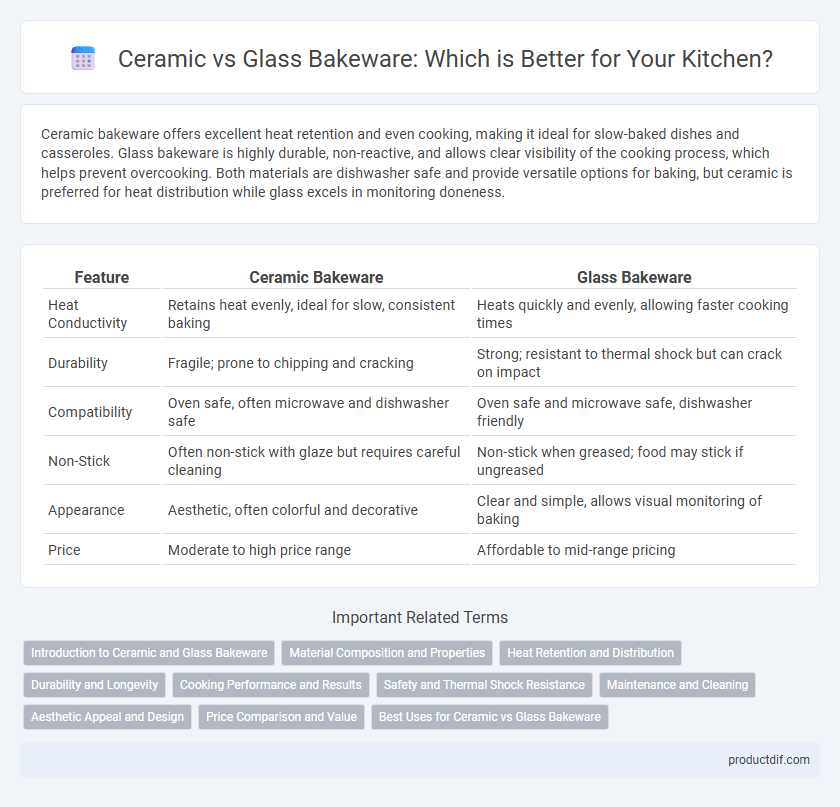Ceramic bakeware offers excellent heat retention and even cooking, making it ideal for slow-baked dishes and casseroles. Glass bakeware is highly durable, non-reactive, and allows clear visibility of the cooking process, which helps prevent overcooking. Both materials are dishwasher safe and provide versatile options for baking, but ceramic is preferred for heat distribution while glass excels in monitoring doneness.
Table of Comparison
| Feature | Ceramic Bakeware | Glass Bakeware |
|---|---|---|
| Heat Conductivity | Retains heat evenly, ideal for slow, consistent baking | Heats quickly and evenly, allowing faster cooking times |
| Durability | Fragile; prone to chipping and cracking | Strong; resistant to thermal shock but can crack on impact |
| Compatibility | Oven safe, often microwave and dishwasher safe | Oven safe and microwave safe, dishwasher friendly |
| Non-Stick | Often non-stick with glaze but requires careful cleaning | Non-stick when greased; food may stick if ungreased |
| Appearance | Aesthetic, often colorful and decorative | Clear and simple, allows visual monitoring of baking |
| Price | Moderate to high price range | Affordable to mid-range pricing |
Introduction to Ceramic and Glass Bakeware
Ceramic bakeware offers excellent heat retention and even cooking, making it ideal for casseroles and baked desserts, while glass bakeware provides transparency for monitoring cooking progress and is non-reactive with acidic ingredients. Both materials are microwave-safe and dishwasher-friendly, with ceramic often featuring an attractive glazed finish and glass known for its durability and resistance to temperature shock. Choosing between ceramic and glass bakeware depends on specific cooking needs, desired aesthetics, and maintenance preferences.
Material Composition and Properties
Ceramic bakeware, composed primarily of natural clay and minerals, offers excellent heat retention and even heat distribution, making it ideal for slow, consistent cooking. Glass bakeware, typically made from tempered soda-lime silica, provides superior visibility, enabling precise monitoring of browning and doneness while maintaining non-reactivity with acidic ingredients. Both materials are durable and resistant to thermal shock, but ceramic's porous surface allows slight absorption of oils, enhancing flavor over time, whereas glass's smooth, non-porous surface ensures easy cleaning and prevents staining.
Heat Retention and Distribution
Ceramic bakeware excels in heat retention, maintaining consistent oven temperatures which ensures even cooking and browning of dishes. Glass bakeware, while slower to heat, offers uniform heat distribution that prevents hot spots and promotes thorough baking. Both materials provide effective cooking results, but ceramic is preferred for recipes requiring steady heat, whereas glass is ideal for recipes benefiting from gradual, even warmth.
Durability and Longevity
Ceramic bakeware offers superior resistance to chipping and scratching, maintaining its integrity over time even with frequent use, while glass bakeware tends to be more prone to breakage due to thermal shock. Both materials provide excellent heat retention, but ceramic's non-porous surface contributes to longer-lasting durability without staining or odor absorption. Choosing ceramic bakeware ensures a durable option that withstands heavy use, whereas glass bakeware requires more careful handling to prolong its lifespan.
Cooking Performance and Results
Ceramic bakeware provides even heat distribution and retains warmth longer, resulting in consistently cooked dishes with a golden crust. Glass bakeware offers excellent heat conductivity and allows visual monitoring of the cooking process, ensuring precise baking and browning. Both materials are non-reactive, preventing flavor alteration and supporting clean, reliable cooking performance.
Safety and Thermal Shock Resistance
Ceramic bakeware offers excellent heat retention and is generally safe for oven use, but it is more prone to thermal shock, which can cause cracking when exposed to sudden temperature changes. Glass bakeware is non-toxic, does not leach chemicals, and provides good thermal shock resistance, making it safer for transferring directly from freezer to oven. Both materials require careful handling, but glass bakeware's durability under temperature fluctuations offers a safety advantage in preventing breakage.
Maintenance and Cleaning
Ceramic bakeware requires gentle hand washing to prevent chipping and maintains a non-stick surface with proper care, though it is dishwasher safe in most cases. Glass bakeware is highly durable, resistant to staining and odors, and can be safely cleaned in the dishwasher without risk of damage. Both materials benefit from avoiding abrasive cleaners to preserve their finish and longevity during kitchen maintenance.
Aesthetic Appeal and Design
Ceramic bakeware offers a rustic and artisanal aesthetic with its vibrant glazes and textured finishes, making it a standout piece in any kitchen display. Glass bakeware provides a sleek, transparent design that allows for easy monitoring of the cooking process while complementing modern and minimalist kitchen styles. Both materials balance functionality with visual appeal, but ceramic often serves as a decorative element, whereas glass emphasizes clarity and simplicity.
Price Comparison and Value
Ceramic bakeware typically offers a higher initial cost but provides excellent heat retention and aesthetic appeal, making it a long-term investment for bakers prioritizing durability and presentation. Glass bakeware is generally more affordable, with the advantage of even heat distribution and easy monitoring of the baking process through transparent material, delivering solid value for everyday use. When comparing price and value, ceramic suits those seeking premium quality and style, while glass bakeware balances cost efficiency and functionality for regular kitchen tasks.
Best Uses for Ceramic vs Glass Bakeware
Ceramic bakeware excels at even heat distribution and retaining heat, making it ideal for casseroles, gratins, and dishes that benefit from prolonged cooking or serving directly from oven to table. Glass bakeware offers excellent visibility for monitoring browning and is best suited for baking pies, brownies, and dishes requiring precise temperature control and quick cooling. Both materials are oven-safe, but ceramic's porous surface enhances slow-cooked meals, while glass's non-porous surface resists stains and odors, ensuring versatile kitchen performance.
Ceramic Bakeware vs Glass Bakeware Infographic

 productdif.com
productdif.com